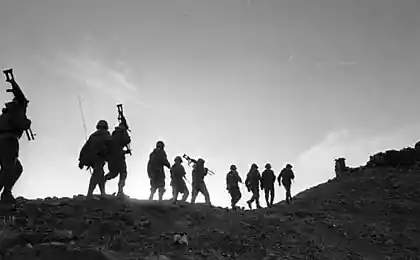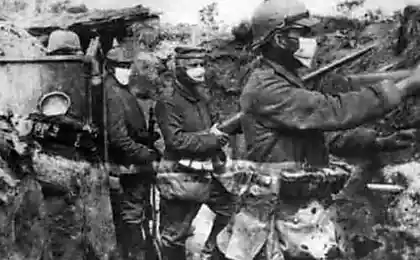967
The attack on the "Tirpitz". Circumstances feat K-21
It was the strongest ship in the theater of operations. Lonely phantom northern seas, whose name terrifies the enemies: all the years of the war, Soviet and British pilots flew 700 sorties to parking "Tirpitz". German battleship for three years forged Fleet in the North Atlantic, forcing the British to drive a squadron of battleships, aircraft carriers and cruisers along the Norwegian fjords. He searched the compound submarines, followed by hunting aircraft and special operations forces. Because of him, he dismissed the convoy PQ-17. German monster survived the attack mini-submarines, and was finally finished off 5-ton bombs parked in Tromsø in November 1944. That's how he was a guy!
She was a tiny half-blind shells, slowly crawling deep in cold water. Spray coating ocular periscope sailor-acoustic sensor and gyro compass showing where the north under the bloody water - here, perhaps, and all that was guided by Nikolai Lunin, going to intercept the German battleship.
source
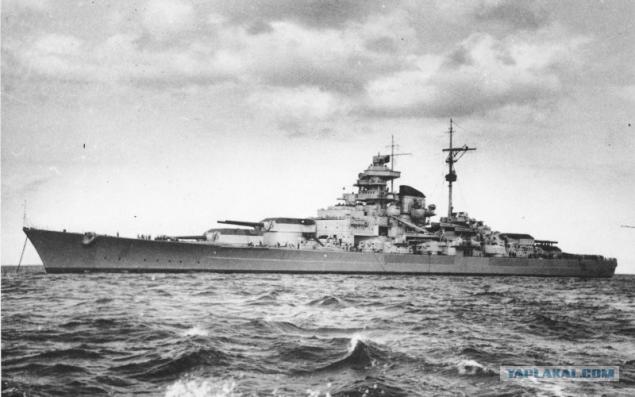
"Tirpitz" was great. Unbeaten 50,000-ton giant with eight 15-inch guns, 320-mm armor belt and the speed of travel 30+ knots.
But the Soviet boat K-21 can not be called an innocent participant in those events. Stealthy submarine - one of the most modern and heavily armed ships in its class that can sneak up on their prey and grab her fangs in 6 bow and stern torpedo tubes 4.
Their meeting took place on July 5, 1942. At 17:00 the German squadron of battleship "Tirpitz", accompanied by the heavy cruiser "Admiral Scheer", "Admiral Hipper" and 9 destroyers escort was found a Soviet submarine. Events hour later formed the basis for the story of the naval investigator for more than 70 years is not leaving the minds of researchers and historians of the Navy.
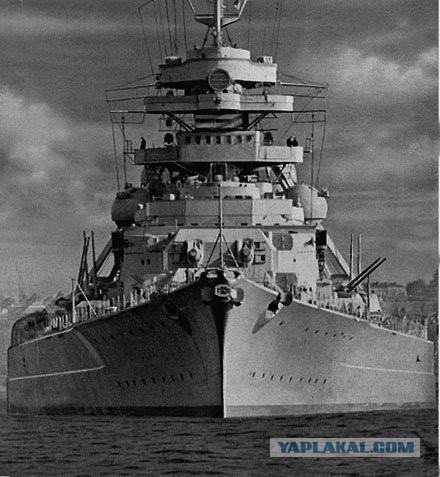
I hit or not Lunin in the "Tirpitz»?
After the active phase of the maneuver, the boat was in not the most favorable position - on divergent courses, at a distance of 18-20 cables from the German squadron. At this point, and was promoted chetyrehtorpedny volley from forage machines. Speed was determined at 22 knots, its true course - 60 ° (according to German data squadron at that time was at a speed of 24 knots. Rate of 90 °).
Acoustic submarine K-21 gave the two branches of the explosion, and then, when the German squadron had hidden away - a series of explosions weaker. N.Lunin suggested that one of the torpedoes hit the battleship, a destroyer in the second and later followed a series of explosions - the detonation of depth charges on a sinking ship.
According to German documents, "Tirpitz" and its escort ships did not notice the fact torpedo attack and have not even seen traces issued torpedoes. The squadron returned to base without losses.
K-21

However, three hours later, at 21:30 fighting campaign was interrupted. German heavy ships lay on the opposite course - submarines and Luftwaffe began to search for and destruction of abandoned ships convoy PQ-17.
These are briefly the raw data of this problem.
Today we are not going to discuss the scheme maneuver K-21 and its position at the time of the attack the German battleship - it was written hundreds of articles, but the authors did not come to the same conclusion. Everything ultimately comes down to the evaluation of the probability that a torpedo battleship.
Acousticians heard explosions and may not be reliable evidence of the success of the attack: according to the most realistic version - torpedo passed limiting distance, sank and detonate on impact with the rocky bottom. A series of explosions far weaker belongs depth bombs dropped on German submarine unspecified (for a number of take it was a British submarine HMS Unshaken, which also tried to attack the day "Tirpitz»).
This rapid folding operation "The Knight" has a simple explanation: the evening of July 5, 1942 the Germans received clear confirmation that the convoy PQ-17 ceased to exist. Chasing single transports - the lot of submarines and aircraft. Large surface ships immediately lay on the opposite course.
However, there is not so simple. At about the same time on board "Tirpitz" received disturbing information - the Germans intercepted a radio message K-21, in which Nikolai Lunin reported on his meeting with the German squadron, and after an attack. Report a Russian submarine, the emergence of the British submarine ... To say that the cowardly German sailors shaking knees, it would be unfair. But the fact of the appearance of the underwater threat was alarmed command. And who knows, the Germans would dare to continue operation even if there would be a convoy PQ-17 is still moved to the port of destination under the protection of a powerful escort?
Command of the Northern Fleet encounters after returning from a hike K-21
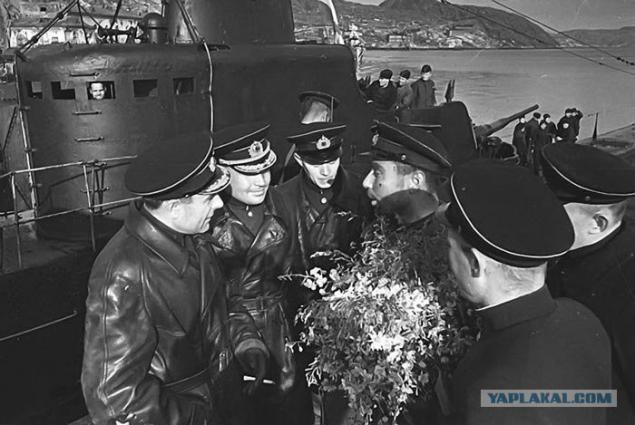
And explanations may be many ...
Instead of all this, I would like to draw attention to a reliable and obvious fact. For example, the devastating impact of a torpedo warhead on the design of the ship.
The Germans could falsify all the magazines, with their usual thoroughness rewrite payroll and applications for the supply of materials and tools from Germany to repair the damaged ship. Take a subscription to disclose all the crews of the squadron. Faked photos. Let Führer slept quietly - with his favorite toy nothing happened ...
The Germans could falsify any documents. But could they have hidden damage "Tirpitz" from prying eyes? Location-based "Tirpitz" was under daily surveillance by British intelligence aircraft; We followed the movements of the battleship Norwegian Resistance agents directly related to British intelligence.
Was there any chance that the "Mosquito" RAF will not notice the repairs and the appearance of bright multi-colored stains of oil leaked from the damaged tank?

The fact that the removal of damage caused by a torpedo would require large-scale works, there is no doubt. During World War II battleships lot of different countries fall under the blows of submarines and torpedo bombers. And every time the consequences are horrific - from detonation cellars and instant death of the ship to the ruined boards, bent shafts, steering gears jammed, torn with supports and mechanisms turbines in the engine room. Underwater explosion of 300 kilos of explosives - this is no joke. No dry-dock is not enough.
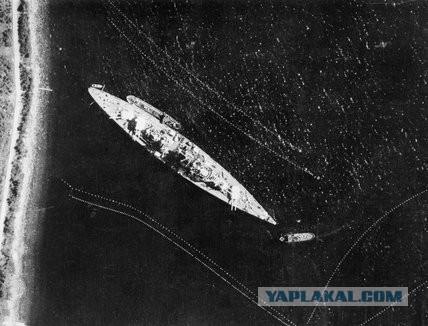
450 mm torpedo landed on the aft starboard side above the right outer propeller (about six meters below the waterline). Explosion 227 kg combat battery compartment torpedo led to enormous destruction: a hole measuring 9 on 3, intensive is flooded corridor right outer propeller shaft, deformed and jammed the shaft (along with the auxiliary wheel to starboard), a leak in the longitudinal and transverse bulkheads in the area of the fourth power . Despite the alarm, several watertight hatches and manholes in the area of the damage were not battened down. By 15:30 the battleship stopped: by the time the 3500 tons of seawater penetrated the aft of the ship from the stern was about three meters and a list to starboard about four and a half degrees.
- The result of a torpedo hit in the Italian battleship "Vittorio Veneto", March 28, 1941
The torpedo exploded on the left side near the stern of the tower 381 mm. The power of the explosion of 340 kg of TNT broke through the underwater constructive protection: in the outer skin formed a hole the size of 13x6 meters, and the ship took 2032 tons of seawater and got the bank at a rate of three and a half degrees to starboard and aft trim of about 2, 2 meters. It killed several dozen people, about the same number were wounded. The bank was able to reduce up to one degree, and remove the trim failed until the return to base.
- The result of the meeting "Vittorio Veneto" from the British submarine HMS Urge, December 14, 1941 Semi-repair provided.
The battleship "Maryland" aviatsionnnoy damaged by a torpedo from Saipan
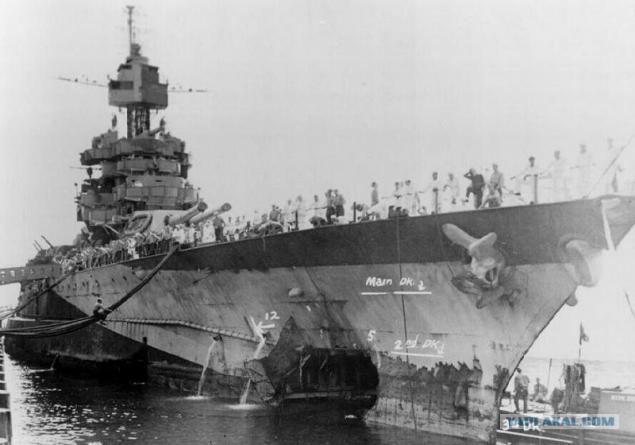
Battleship "North Caroline." The result of a torpedo hit, released the Japanese submarine I-19

Incredibly, after only three months after the events of July 5, 1942 "Tirpitz" also require complex repair!
October 23, 1942 "Tirpitz" went from Narvik to Trondheim. There also came floating workshop "Hauskaran." The Germans built the caisson and over the next three months spent ... preventive replacement rudder battleship. It is time to exclaim "Eureka" and throw up his hat. Do we find evidence of a successful attack Lunin?
Experienced experts and investigators for especially important cases are asked to remain calm and not to jump to conclusions - to discover the connection between the torpedo attack July 5, 1942 and repairs during the autumn-winter 1942-43. not so easy. If a torpedo caused the damage to the rudders - how "Tirpitz" avoid repeating the fate of his brother - "Bismarck"? While the British 457 mm torpedo aircraft Mk XII just funny cracker on a background of Soviet combined-cycle 53-38, who shot the boat K-21 (weight 1615 kg against 702 kg explosive charge - 300 kg against 176 kg in Mk XII). Such a thing had spread "Tirpitz" full aft and damage not only the steering wheel, and screws.
"Tirpitz" returns to base after an operation to intercept the convoy PQ-17
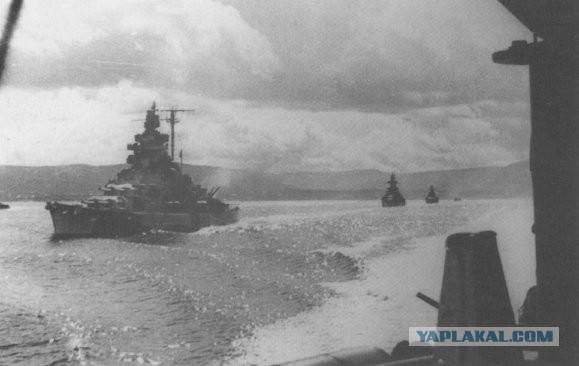
However, it is known that from the campaign "Tirpitz" returned under their own power, the transition to Trondheim are also carried out on their own. No significant repairs at the side of the battleship during his stay in the Gulf of Bogen was conducted. Oil spills, and the stern was observed. Is there a relationship between the repairs and torpedo attack Lunin? Or Repair - a consequence of some other event?
The version with a navigation accident can be rejected as untenable. One look at the location of the rudders battleship to make: to damage them is possible only if the pre-strut body on the rocks along its entire length. However, there is a version with damaged rudder when reversing during the mooring - this could happen if all the members of the crew were drunk superlinkora as Untermensch.
Could it have been any combat damage? Alternatively, the rudder could be damaged during the bombing of one of the many parking spaces battleship:
March 30-31, 1941. - Plaque 33 "Halifaxes» Trondheim (unsuccessfully, shot down six);
April 27-28, 1941. - Plaque 29 "Halifaxes" and 11 "Lancaster" (to no avail, shot down five);
April 28-29, 1941. - Plaque 23 "Halifaxes" and 11 "Lancaster" (to no avail, two shot down);
...
Close gaps dozen bombs could not harm armored monster, but underwater hydrodynamic shocks could easily damage the drive wheel and mutilate his pen. Finally, the tension of the metal caused cracks and dents completed the begun business - ship in half a year it took a complex repair. Versions can be many. But none of them is like a torpedo hit - damage should be much more serious, rather than those that led to a three-month repair battleship in Trondheim.
But what was the second torpedo?
Four released a torpedo submarine heard two explosions ... could she hit the second shot?
Official Soviet historiography linked to a second explosion hit one of the destroyer escort. But who got a gift from Nikolai Lunin? Is there any evidence of damage destroyers?
Imagine there!
If we trace the path of each of the combat destroyers that took part in the operation, "The Knight", it turns out that after only 10 days, 15-17 July 1942 took place the transition destroyers Z-24, and "Frederick John" from Norway to Germany. What was the reason the translation of ships, not reported. Is it really to eliminate combat damage ?!
But even here there are a number of issues. Even before the departure to his native shores, July 8-10 destroyers Z-24, and "John Frederick", supported by torpedo boats T7 and T15 conducted an operation to transfer the damaged turbocharger "Lutzow" from Narvik to Trondheim (as has been damaged "Lutzow" - about this below). This "wounded animal" not satisfied and had another operation on putting minefield in the North Sea (14-15 July 1942)
Something does not seem to ship complete in / and slightly more than 3,000 tons of sustained penetration of 533 mm torpedoes, and then calmly "walked" in the North Sea, exhibited mines, and its course was getting bypassing Scandinavia to Germany.
From torpedoes suffered severely, even huge, perfectly protected battleships - what will happen in this case, a small destroyer? Even if it does not break in half, the damage will be so powerful that he and a month is unlikely to come to the sea. You can quickly weld sheets of damaged skin, but what to do with bent shafts and propellers ripped from their seats turbines?

In fact, the Germans were pretty good reason to send its destroyers for repairs to Kiel. Operation "The Knight" had no luck from the very beginning - during maneuvering in narrow fjords, TCR "Lutzow" along with the destroyers "Hans Lodi," "Karl Galster" and "Theodor Riedel" swooped down on the rocks and were damaged in the underwater hull. Alas, none of these ships did not appear in the "sent for repair to Germany».
Epilogue
Two explosions, heard on board the K-21. Suspiciously quick return battleship. Oktyabrsky translation of "Tirpitz" in Trondheim. The three-month renovation. The caisson. Replacing the rudder. Urgent translation destroyers from Narvik to Germany. Is it too much of a coincidence for a conventional story?
There are other "coincidence»:
Nikolai Lunin spent his career just one successful (confirmation) torpedo attack - transport "Consul Schulte," 02/05/1942, the
The crew of the K-21 had no experience of fast-attack warships.
Attack with maximum distance of 18-20 cab. on divergent courses.
How torpedo installed to a depth of 2 m stroke, appeared at a depth of 5-8 meters (at a depth below the waterline are the handlebars). Turbulent flows screws? Let's say ...
Despite all the speculation and coincidence, it is likely that the submarine K-21 still shot wide of the goal. Further events related to the autumn-winter repairs battleship as poorly fit into the outline of events from the torpedo hit. And who, in this case, the second torpedo hit?
One thing is certain: the crew of the K-21 has demonstrated exceptional courage, for the first time in the Soviet Navy having carried out an attack of such a complex and well-protected targets. Having intercepted a radio message K-21, officers of the largest ship Krigsmarine certainly experienced an unpleasant thrill to learn that Soviet submarines were attacked, while the submarine remained unnoticed on board German ships.
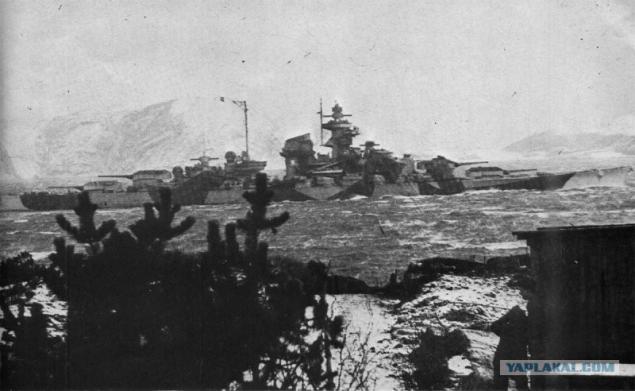
Damaged "Tirpitz" after the operation "Wolfram". The ship was hit by 14 bombs of medium and large caliber, shake broke the old wounds inflicted on the beast just before a series of mini-submarines XE. Good smudge of oil on the water rasteksheysya. Renovation is in full swing in July 1944
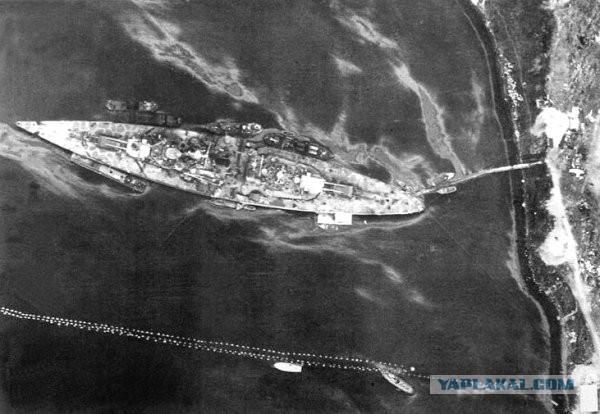
The submarine K-21 on eternal parking in Severomorsk
all.
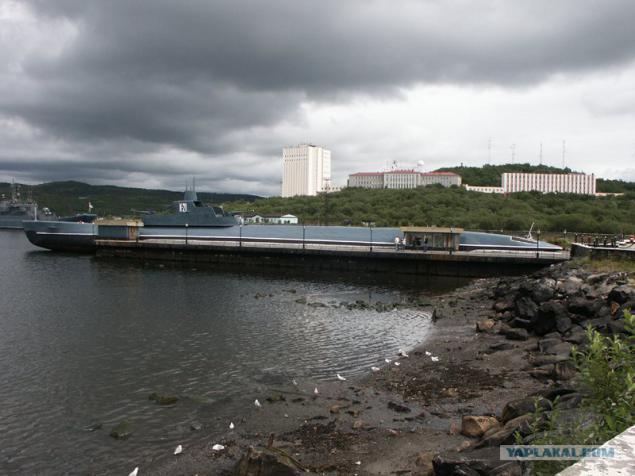
Source:
She was a tiny half-blind shells, slowly crawling deep in cold water. Spray coating ocular periscope sailor-acoustic sensor and gyro compass showing where the north under the bloody water - here, perhaps, and all that was guided by Nikolai Lunin, going to intercept the German battleship.
source

"Tirpitz" was great. Unbeaten 50,000-ton giant with eight 15-inch guns, 320-mm armor belt and the speed of travel 30+ knots.
But the Soviet boat K-21 can not be called an innocent participant in those events. Stealthy submarine - one of the most modern and heavily armed ships in its class that can sneak up on their prey and grab her fangs in 6 bow and stern torpedo tubes 4.
Their meeting took place on July 5, 1942. At 17:00 the German squadron of battleship "Tirpitz", accompanied by the heavy cruiser "Admiral Scheer", "Admiral Hipper" and 9 destroyers escort was found a Soviet submarine. Events hour later formed the basis for the story of the naval investigator for more than 70 years is not leaving the minds of researchers and historians of the Navy.

I hit or not Lunin in the "Tirpitz»?
After the active phase of the maneuver, the boat was in not the most favorable position - on divergent courses, at a distance of 18-20 cables from the German squadron. At this point, and was promoted chetyrehtorpedny volley from forage machines. Speed was determined at 22 knots, its true course - 60 ° (according to German data squadron at that time was at a speed of 24 knots. Rate of 90 °).
Acoustic submarine K-21 gave the two branches of the explosion, and then, when the German squadron had hidden away - a series of explosions weaker. N.Lunin suggested that one of the torpedoes hit the battleship, a destroyer in the second and later followed a series of explosions - the detonation of depth charges on a sinking ship.
According to German documents, "Tirpitz" and its escort ships did not notice the fact torpedo attack and have not even seen traces issued torpedoes. The squadron returned to base without losses.
K-21

However, three hours later, at 21:30 fighting campaign was interrupted. German heavy ships lay on the opposite course - submarines and Luftwaffe began to search for and destruction of abandoned ships convoy PQ-17.
These are briefly the raw data of this problem.
Today we are not going to discuss the scheme maneuver K-21 and its position at the time of the attack the German battleship - it was written hundreds of articles, but the authors did not come to the same conclusion. Everything ultimately comes down to the evaluation of the probability that a torpedo battleship.
Acousticians heard explosions and may not be reliable evidence of the success of the attack: according to the most realistic version - torpedo passed limiting distance, sank and detonate on impact with the rocky bottom. A series of explosions far weaker belongs depth bombs dropped on German submarine unspecified (for a number of take it was a British submarine HMS Unshaken, which also tried to attack the day "Tirpitz»).
This rapid folding operation "The Knight" has a simple explanation: the evening of July 5, 1942 the Germans received clear confirmation that the convoy PQ-17 ceased to exist. Chasing single transports - the lot of submarines and aircraft. Large surface ships immediately lay on the opposite course.
However, there is not so simple. At about the same time on board "Tirpitz" received disturbing information - the Germans intercepted a radio message K-21, in which Nikolai Lunin reported on his meeting with the German squadron, and after an attack. Report a Russian submarine, the emergence of the British submarine ... To say that the cowardly German sailors shaking knees, it would be unfair. But the fact of the appearance of the underwater threat was alarmed command. And who knows, the Germans would dare to continue operation even if there would be a convoy PQ-17 is still moved to the port of destination under the protection of a powerful escort?
Command of the Northern Fleet encounters after returning from a hike K-21

And explanations may be many ...
Instead of all this, I would like to draw attention to a reliable and obvious fact. For example, the devastating impact of a torpedo warhead on the design of the ship.
The Germans could falsify all the magazines, with their usual thoroughness rewrite payroll and applications for the supply of materials and tools from Germany to repair the damaged ship. Take a subscription to disclose all the crews of the squadron. Faked photos. Let Führer slept quietly - with his favorite toy nothing happened ...
The Germans could falsify any documents. But could they have hidden damage "Tirpitz" from prying eyes? Location-based "Tirpitz" was under daily surveillance by British intelligence aircraft; We followed the movements of the battleship Norwegian Resistance agents directly related to British intelligence.
Was there any chance that the "Mosquito" RAF will not notice the repairs and the appearance of bright multi-colored stains of oil leaked from the damaged tank?

The fact that the removal of damage caused by a torpedo would require large-scale works, there is no doubt. During World War II battleships lot of different countries fall under the blows of submarines and torpedo bombers. And every time the consequences are horrific - from detonation cellars and instant death of the ship to the ruined boards, bent shafts, steering gears jammed, torn with supports and mechanisms turbines in the engine room. Underwater explosion of 300 kilos of explosives - this is no joke. No dry-dock is not enough.

450 mm torpedo landed on the aft starboard side above the right outer propeller (about six meters below the waterline). Explosion 227 kg combat battery compartment torpedo led to enormous destruction: a hole measuring 9 on 3, intensive is flooded corridor right outer propeller shaft, deformed and jammed the shaft (along with the auxiliary wheel to starboard), a leak in the longitudinal and transverse bulkheads in the area of the fourth power . Despite the alarm, several watertight hatches and manholes in the area of the damage were not battened down. By 15:30 the battleship stopped: by the time the 3500 tons of seawater penetrated the aft of the ship from the stern was about three meters and a list to starboard about four and a half degrees.
- The result of a torpedo hit in the Italian battleship "Vittorio Veneto", March 28, 1941
The torpedo exploded on the left side near the stern of the tower 381 mm. The power of the explosion of 340 kg of TNT broke through the underwater constructive protection: in the outer skin formed a hole the size of 13x6 meters, and the ship took 2032 tons of seawater and got the bank at a rate of three and a half degrees to starboard and aft trim of about 2, 2 meters. It killed several dozen people, about the same number were wounded. The bank was able to reduce up to one degree, and remove the trim failed until the return to base.
- The result of the meeting "Vittorio Veneto" from the British submarine HMS Urge, December 14, 1941 Semi-repair provided.
The battleship "Maryland" aviatsionnnoy damaged by a torpedo from Saipan

Battleship "North Caroline." The result of a torpedo hit, released the Japanese submarine I-19

Incredibly, after only three months after the events of July 5, 1942 "Tirpitz" also require complex repair!
October 23, 1942 "Tirpitz" went from Narvik to Trondheim. There also came floating workshop "Hauskaran." The Germans built the caisson and over the next three months spent ... preventive replacement rudder battleship. It is time to exclaim "Eureka" and throw up his hat. Do we find evidence of a successful attack Lunin?
Experienced experts and investigators for especially important cases are asked to remain calm and not to jump to conclusions - to discover the connection between the torpedo attack July 5, 1942 and repairs during the autumn-winter 1942-43. not so easy. If a torpedo caused the damage to the rudders - how "Tirpitz" avoid repeating the fate of his brother - "Bismarck"? While the British 457 mm torpedo aircraft Mk XII just funny cracker on a background of Soviet combined-cycle 53-38, who shot the boat K-21 (weight 1615 kg against 702 kg explosive charge - 300 kg against 176 kg in Mk XII). Such a thing had spread "Tirpitz" full aft and damage not only the steering wheel, and screws.
"Tirpitz" returns to base after an operation to intercept the convoy PQ-17

However, it is known that from the campaign "Tirpitz" returned under their own power, the transition to Trondheim are also carried out on their own. No significant repairs at the side of the battleship during his stay in the Gulf of Bogen was conducted. Oil spills, and the stern was observed. Is there a relationship between the repairs and torpedo attack Lunin? Or Repair - a consequence of some other event?
The version with a navigation accident can be rejected as untenable. One look at the location of the rudders battleship to make: to damage them is possible only if the pre-strut body on the rocks along its entire length. However, there is a version with damaged rudder when reversing during the mooring - this could happen if all the members of the crew were drunk superlinkora as Untermensch.
Could it have been any combat damage? Alternatively, the rudder could be damaged during the bombing of one of the many parking spaces battleship:
March 30-31, 1941. - Plaque 33 "Halifaxes» Trondheim (unsuccessfully, shot down six);
April 27-28, 1941. - Plaque 29 "Halifaxes" and 11 "Lancaster" (to no avail, shot down five);
April 28-29, 1941. - Plaque 23 "Halifaxes" and 11 "Lancaster" (to no avail, two shot down);
...
Close gaps dozen bombs could not harm armored monster, but underwater hydrodynamic shocks could easily damage the drive wheel and mutilate his pen. Finally, the tension of the metal caused cracks and dents completed the begun business - ship in half a year it took a complex repair. Versions can be many. But none of them is like a torpedo hit - damage should be much more serious, rather than those that led to a three-month repair battleship in Trondheim.
But what was the second torpedo?
Four released a torpedo submarine heard two explosions ... could she hit the second shot?
Official Soviet historiography linked to a second explosion hit one of the destroyer escort. But who got a gift from Nikolai Lunin? Is there any evidence of damage destroyers?
Imagine there!
If we trace the path of each of the combat destroyers that took part in the operation, "The Knight", it turns out that after only 10 days, 15-17 July 1942 took place the transition destroyers Z-24, and "Frederick John" from Norway to Germany. What was the reason the translation of ships, not reported. Is it really to eliminate combat damage ?!
But even here there are a number of issues. Even before the departure to his native shores, July 8-10 destroyers Z-24, and "John Frederick", supported by torpedo boats T7 and T15 conducted an operation to transfer the damaged turbocharger "Lutzow" from Narvik to Trondheim (as has been damaged "Lutzow" - about this below). This "wounded animal" not satisfied and had another operation on putting minefield in the North Sea (14-15 July 1942)
Something does not seem to ship complete in / and slightly more than 3,000 tons of sustained penetration of 533 mm torpedoes, and then calmly "walked" in the North Sea, exhibited mines, and its course was getting bypassing Scandinavia to Germany.
From torpedoes suffered severely, even huge, perfectly protected battleships - what will happen in this case, a small destroyer? Even if it does not break in half, the damage will be so powerful that he and a month is unlikely to come to the sea. You can quickly weld sheets of damaged skin, but what to do with bent shafts and propellers ripped from their seats turbines?

In fact, the Germans were pretty good reason to send its destroyers for repairs to Kiel. Operation "The Knight" had no luck from the very beginning - during maneuvering in narrow fjords, TCR "Lutzow" along with the destroyers "Hans Lodi," "Karl Galster" and "Theodor Riedel" swooped down on the rocks and were damaged in the underwater hull. Alas, none of these ships did not appear in the "sent for repair to Germany».
Epilogue
Two explosions, heard on board the K-21. Suspiciously quick return battleship. Oktyabrsky translation of "Tirpitz" in Trondheim. The three-month renovation. The caisson. Replacing the rudder. Urgent translation destroyers from Narvik to Germany. Is it too much of a coincidence for a conventional story?
There are other "coincidence»:
Nikolai Lunin spent his career just one successful (confirmation) torpedo attack - transport "Consul Schulte," 02/05/1942, the
The crew of the K-21 had no experience of fast-attack warships.
Attack with maximum distance of 18-20 cab. on divergent courses.
How torpedo installed to a depth of 2 m stroke, appeared at a depth of 5-8 meters (at a depth below the waterline are the handlebars). Turbulent flows screws? Let's say ...
Despite all the speculation and coincidence, it is likely that the submarine K-21 still shot wide of the goal. Further events related to the autumn-winter repairs battleship as poorly fit into the outline of events from the torpedo hit. And who, in this case, the second torpedo hit?
One thing is certain: the crew of the K-21 has demonstrated exceptional courage, for the first time in the Soviet Navy having carried out an attack of such a complex and well-protected targets. Having intercepted a radio message K-21, officers of the largest ship Krigsmarine certainly experienced an unpleasant thrill to learn that Soviet submarines were attacked, while the submarine remained unnoticed on board German ships.

Damaged "Tirpitz" after the operation "Wolfram". The ship was hit by 14 bombs of medium and large caliber, shake broke the old wounds inflicted on the beast just before a series of mini-submarines XE. Good smudge of oil on the water rasteksheysya. Renovation is in full swing in July 1944

The submarine K-21 on eternal parking in Severomorsk
all.

Source:









